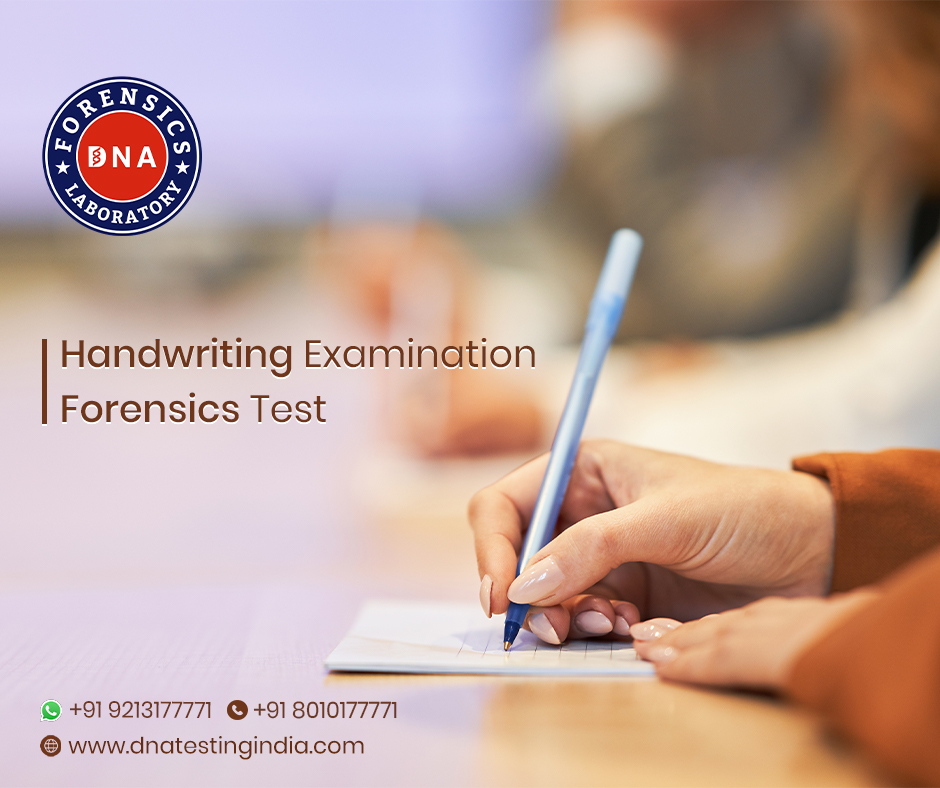Decoding Handwriting: How Forensic Specialists Authenticate Documents
We provide accurate & highly reliable Handwriting Examination tests.

Handwriting is a distinctive form of personal expression, much like fingerprints. Every loop, stroke, and curve show intricate details about the person behind the pen. Handwriting examination, also called graphology in some contexts, is a captivating blend of science and art used for various personal, legal, and investigative purposes.
What is a Handwritten Examination?
Handwriting examination is the scientific examination of documented scripts to recognize, compare, or authenticate the authorship of a document. Specialists in this field, called document examiners or handwriting examiners, evaluate the traits, style, & patterns of handwriting to conclude its origin. This technique is most commonly employed in:
- Legal Investigations: Forensic handwritten examination is frequently vital in forgeries, fraud cases, and criminal investigations.
- Authentication: Proving signatures on contracts, wills, or checks.
- Personality Analysis: While controversial, graphology tries to infer personality characteristics from handwriting.
The Principles of Handwriting Analysis
Handwriting analysis depends on the fundamental principle that every person’s writing is unique. This identity stems from physiological, neurological, and psychological factors. Critical features examined in handwriting include:
- Letter Formation: The size, shape, and angles of letters.
- Spacing: The space between words & lines.
- Slant: The extent to which letters lean backward or forward.
- Pressure: The force applied on the paper surface, visible via the thickness or depth of strokes.
- Consistency: Patterns of uniformity or interpretation in writing style.
How is a Handwritten Examination Performed?
Handwritten examination is a meticulous procedure that involves numerous steps:
- Collection of Samples: Examiners get known samples from the questioned writer. These are compared with the questioned document to determine similarities or dissimilarities.
- Analysis of Features: The examiner looks at individual traits such as spacing, pen pressure, and letter formation.
- Comparison: Both documents are compared for unique traits, patterns, or consistencies.
- Evaluation: Experts evaluate the probability that the same person authored both samples.
- Conclusion: A thorough report is prepared and frequently utilized as proof in legal or investigative contexts.
Applications of Handwriting Examination
Handwriting examination has various applications across diverse fields:
Forensic Investigations: In criminal matters, handwriting analysis determines the authorship of ransom notes, threatening letters, or forged documents. For instance:
- Fraud Cases: Detecting falsified signatures on contracts, checks, or identification documents.
- Cybercrime: Confirming handwritten notes or signatures related to online fraud.
Legal Disputes: Handwriting analysis plays a vital role in civil litigation, such as:
- Will Disputes: Proving handwritten codicils or wills.
- Contractual Disputes: Confirming signatures on legal documents or agreements.
Employment Screening: In some initiatives, a handwritten examination assesses personality characteristics for recruitment or promotional decisions. While this application is contentious and lacks scientific confirmation, it remains famous in certain regions.
Psychological Studies: Graphologists claim that writing discloses psychological characteristics such as emotional stability, confidence, and mental health. Though not universally accepted, this factor of handwriting analysis garners interest.
Academic Integrity: Handwritten examinations can detect forged signatures on certificates, educational records, or admission documents.
The Science Behind Handwriting Examination
Modern handwriting analysis is rooted in strict scientific principles. Unlike graphology, which is mainly subjective, forensic handwriting examination depends on practical methods. Instruments such as microscopes, magnifying lenses, and computerized systems improve precision in pinpointing subtle variations and patterns. One significant improvement is the usage of digital forensic tools, which allow specialists to:
- Examine writing speed and pressure.
- Compare thousands of writing samples in reference databases.
- Detect micro-level deviations invisible to the naked eye.
The Role of Handwritten Analysis in Forensic Science
Forensic handwriting examination is a vital instrument in modern investigations. It completes other forensic techniques, such as fingerprint examination and DNA test. In addition, it is non-invasive nature makes it perfect for document authentication without damaging original proof.
Why Select Skilled Handwriting Examiners?
The precision of handwriting examination largely relies on the expertise of the examiner. Experienced handwriting examiners:
- Possess technical training in forensic document examination.
- Follow moral guidelines and scientific protocols.
- Deliver credible reports permissible in courts of law.
DNA Forensics Laboratory Pvt. Ltd - Accurate and Reliable Handwritten Examination
DNA Forensics Laboratory Pvt. Ltd. offers accurate and dependable handwriting examination services, using cutting-edge forensic techniques to examine and authenticate handwriting. With a team of experienced experts and advanced tools, the lab guarantees precise identification of handwriting patterns, dissimilarities, and authenticity in different documents. Whether for fraud investigation, legal purposes, or personal disputes, the lab provides trustworthy handwriting analysis reports that are admissible in court, ensuring a comprehensive and professional evaluation.
